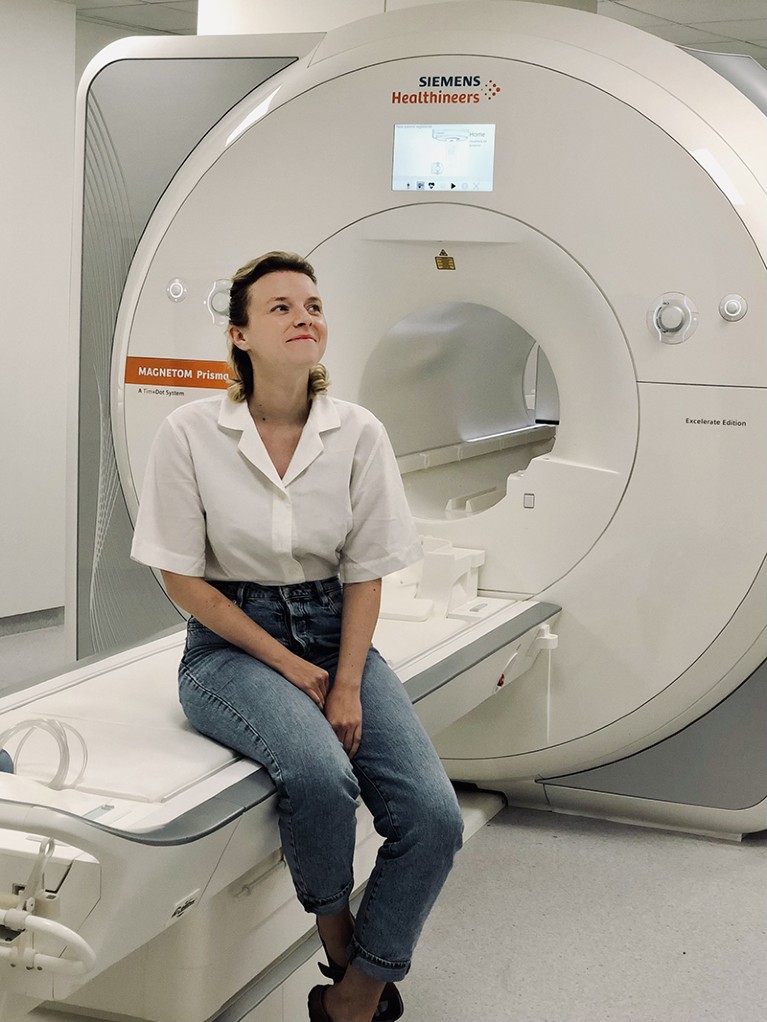
Researchers are cataloguing the effects of birth control on the brain.
Credit: Isabel Pavia/Getty
Chicago, Illinois
Hold the morning coffee and meditation: for about 75 days over the span of a year, neuroscientist Carina Heller’s morning ritual included climbing into her university’s brain scanner at 7:30 a.m. and lying perfectly still for an hour and a half — without falling asleep. By her estimates, this has made her the most-scanned woman in science.
It’s not the title she was after. Heller’s goal was to catalogue how her brain changes during her menstrual cycle, with and without
oral contraceptives
. Her findings suggest that brain morphology and connectivity change daily throughout the natural cycle and are influenced by birth-control pills, according to preliminary results presented at this year’s annual Society for Neuroscience conference.
Heller is one of a cadre of women’s health researchers who are tired of waiting for data to trickle in on a
chronically understudied
area, and have taken matters into their own hands by hopping into a brain-imaging machine. More data could offer women and their physicians greater agency to make “better-informed decisions of whether they want to take the medication or not”, and what specific formulations might be best suited for them, says Heller, who is based at the University of Minnesota Twin Cities in Minneapolis.
“She did this rigorous self-experimentation where she gave herself up to science,” says Emily Jacobs, a neuroscientist at the University of California, Santa Barbara, who works with Heller. “And as a result, we now have this greater insight into the human brain.”
Research gaps
Oral contraceptives often contain synthetic versions of one or two hormones the body naturally produces: progesterone and oestrogen. These hormones prevent pregnancy in several ways, including by stopping the ovaries from releasing an egg.
US regulators approved the first oral contraceptive in 1960. Within two years, more than one million people were taking ‘the pill’, as it became known. Today, more than 150 million people of reproductive age globally take oral contraceptives, placing them among the most-used medications in the world. Many take the pill for reasons unrelated to conception, such as managing acne, regulating menstrual cycles or helping to relieve menstrual symptoms and migraines.
Decades of data on these medicines suggest that they are generally safe, but their effects on the brain remain understudied. For example, although some people report that they experience decreased depression and anxiety, others find that these symptoms worsen — and it’s unclear why.
Many people begin taking the pill during puberty, which is a crucial time for brain maturation, so it’s important to understand how it affects neurodevelopment, says Kathryn Lenz, a behavioural neuroscientist at The Ohio State University in Columbus.
The adaptable brain
Most neuroimaging experiments use magnetic resonance imaging (MRI) technology to scan the brains of 10–30 participants only once or twice, which is costly to perform. This approach fails to account for daily variation in brain morphology and connectivity.
A growing number of neuroimaging studies instead use a technique called ‘
dense sampling
’, in which researchers scan a single or handful of participants repeatedly to build a high-resolution data set. Dense sampling captures observations that might otherwise be overlooked, but the small sample size results in limited generalizability of findings to larger populations.
Even so, by comparing data sets between participants — especially those who have different reactions to the pill — researchers might be able to pinpoint what drives different side effects.

Neuroscientist Carina Heller has joined a cadre of investigators who fill gaps in women’s health research by hopping into brain-imaging machines themselves.
Credit: Ann-Christine Buck
Using this approach, Heller scanned herself 25 times over 5 weeks, capturing images at different stages of her natural menstrual cycle. A few months later, she began taking oral contraceptives and then waited 3 months before scanning herself another 25 times in 5 weeks. At that point, Heller ceased taking the pill, waited another 3 months and scanned herself a final 25 times over 5 weeks. She also had blood drawn and completed a survey about her mood after each scan.
Heller found a rhythmic pattern of change in brain volume and connectivity between brain regions over the course of her menstrual cycle, with volume and connectivity dipping slightly while she was taking oral contraceptives. (Higher brain volume or connectivity does not imply improved brain function, and vice versa.)
This pattern largely returned to its former state after she stopped taking the medication, showing that the brain is “quite adaptable”, says Laura Pritschet, who conducted her graduate work with Jacobs and is now a cognitive neuroscientist at the University of Pennsylvania in Philadelphia.
An expanding network
Heller drew inspiration from a study in which Pritschet scanned her own brain for 30 consecutive days during her natural menstrual cycle and for 30 more days while taking oral contraceptives. This was part of a project that Pritschet calls 28andMe: the name is a nod to the consumer-genetics firm 23andMe in South San Francisco, California, and the 28 days in a canonical menstrual cycle.
Data from Pritschet’s project showed that higher levels of oestrogen drive certain important brain networks to become more functionally connected
1
. One of these was the ‘default mode network’, which is active during daydreaming and is involved in memory. Progesterone had the opposite effect. Pritschet also scanned her husband over 30 consecutive days in a spin-off project called 28andHe, to understand the effects of hormone fluctuations in the male brain
2
.
Next, Heller plans to compare her data with those from a woman with endometriosis, a painful condition that affects up to 10% of reproductive age women, to understand whether hormone fluctuations in the brain could be driving the condition.
These data sets are “going to give us a really intriguing window into the relationship between hormonal status and subtle changes in brain structure and behavioural functions”, Lenz says.
This article refers to ‘women’s health’ to reflect language used about these fields, although
Nature
recognizes that not everyone affected is a woman.


